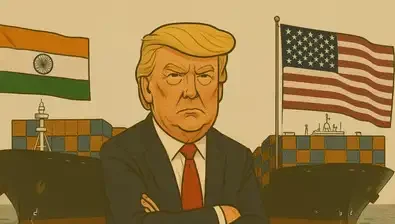“It’s Getting Late”: Trump Claims India Has Offered to Reduce Tariffs to Zero
Introduction
In a series of high-profile remarks made on September 1, 2025, former U.S. President Donald Trump reignited a fierce debate over U.S.–India trade dynamics, declaring that India has offered to reduce tariffs on American goods to zero. Yet, his tagline—“but it’s getting late”—added a layer of urgency and retrospection. The claim aligns with Trump’s core “America First” trade doctrine, highlighting what he frames as decades of one-sided trade practices disadvantageous to American businesses.
Trump’s Contentious Assertion
Trump shared his views on the social media platform Truth Social, stating: “They have now offered to cut their tariffs to nothing, but it’s getting late. They should have done so years ago.” He added that the U.S.–India relationship has been “totally one-sided” and characterized it as a “disaster,” accusing India of favoring other markets, particularly Russia, with its purchases of oil and military equipment Reuters+1The Economic TimesThe Washington Post.
Media Coverage and Reactions
Several major news outlets covered this development:
-
Reuters highlighted Trump’s comments made during his widely observed SCO summit attendance and framed them within the broader context of U.S.–India tensions and recent tariff hikes Reuters.
-
Economic Times emphasized the critical undertone: India’s peek toward tariff elimination is “getting late,” reflecting frustration with India’s delayed response The Economic Times.
-
The Washington Post and op-ed contributors warned that Trump’s aggressive posture might erode long-term strategic cooperation, especially as India navigates the complexities of balancing ties between the West, Russia, and China The Washington Post.
-
Meanwhile, the Times of India challenged Trump’s “one-sided trade” narrative, citing data pointing to a substantial U.S. benefit—annual surplus of $35–40 billion when considering multiple trade flows The Times of India.
India’s Position and Context
India has yet to issue an official response to the latest remarks, and no formal confirmation has emerged on an actual zero-tariff proposal. Meanwhile, the backdrop to this claim includes:
-
Tariff escalation: In early 2025, Trump imposed a 25% “reciprocal” tariff and an additional 25% “penalty” linked to India’s purchase of Russian oil—resulting in a total duty of 50% on many Indian exports WikipediaReuters.
-
Historical proactive outreach: Earlier in the year, during PM Modi’s February 2025 visit to the U.S., India did offer some tariff reductions—e.g., in motorcycles and whiskey—and expressed willingness to review and lower duties on 55% of U.S. imports, though not zeroing them across the board Wikipedia+1.
-
Strategic ambiguity: India’s engagement with Russia and China, exemplified by interactions at the SCO summit, underscores its multipolar strategy and caution against yielding ground solely to Western pressure ReutersWikipedia.
Analytical Insights
1. Questioning the “One-Sided Disaster” Frame
Trump’s framing of the U.S.–India trade relationship as irrevocably tilted in India’s favor is challenged by trade data. The GTRI analysis, referenced by Times of India, suggests that when all revenues and service flows are considered, the U.S. enjoys a positive trade balance with India—undermining the narrative of a unilateral disadvantage The Times of India.
2. Strategic vs. Tactical Pressure
Trump’s surging tariffs operate as a blunt instrument aimed at achieving rapid economic concessions. However, analysts argue that such tactics may undermine strategic priorities—especially in maintaining India as a key partner in the Indo-Pacific counterbalance to China The Washington PostWikipedia.
3. Diplomatic Timing and Image
Trump’s comment—“but it’s getting late”—suggests the U.S. perceives its strategic window closing, particularly as India appears more comfortable exploring ties with non-Western powers. The optics of Modi walking hand-in-hand with Putin and Xi at the SCO summit may symbolize a shifting geopolitical posture The Daily BeastReuters.
4. The Importance of Verifiable Policy Intentions
While U.S. perspectives claim India offered zero tariffs, Indian sources have not confirmed such a proposal. Past offers were nuanced and contingent, tailored around selective sectors under threat of rising U.S. retaliatory tariffs—not blanket zeroing Wikipedia+1.
Broader Implications
A. For U.S. Economic Strategy
Trump’s approach may aim for assertive economic gains but overlooks systemic interdependencies. Indian-origin products and components are deeply woven into U.S. supply lines—raising questions whether punitive tariffs could rebound on American firms and consumers Wikipedia+1.
B. For India’s Global Alignment
India’s refusal to immediately acquiesce to U.S. pressure and its calculated multi-vector diplomacy signals a broader strategic reorientation. Balancing interests among the U.S., Russia, and China might provide New Delhi with resilience—though it may raise concerns in Washington.
C. Diplomatic Fallout
Elevated tensions and aggressive tariff postures risk eroding the trust and alignment built over decades. As some experts have warned, this could undercut cooperative platforms like the Quad or integrated regional strategies against Chinese influence The Washington PostWikipedia.
Conclusion
Donald Trump’s assertion—that India offered to reduce tariffs to zero, albeit “too late”—forms a compelling, if contested, narrative in the U.S.–India trade saga. It underscores the intensity of tariffs used as geopolitical leverage and reflects broader anxieties over shifting global power balances.
While Trump portrays the offer as a belated olive branch, India’s silence and the lack of formal confirmation leave the claim in the realm of high-stakes rhetoric. If realized, zero tariffs could reshape bilateral trade—but the lasting impact hinges on trust, reciprocity, and whether strategic cooperation can withstand tariff-driven brinkmanship.
Unlocking AI: Why Mathematical Basics Are the Key to AI Mystery
Negative Training Data: Challenges, Applications, and Future Directions





